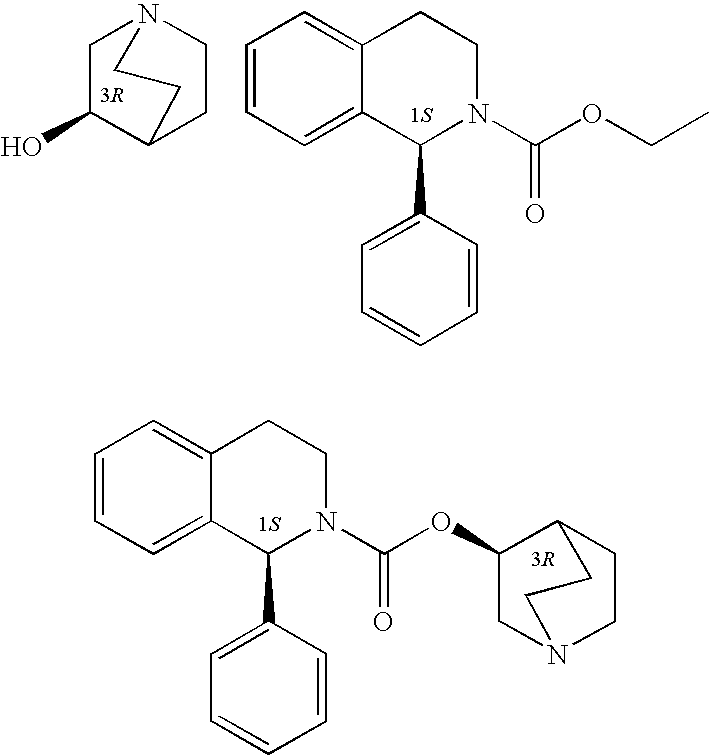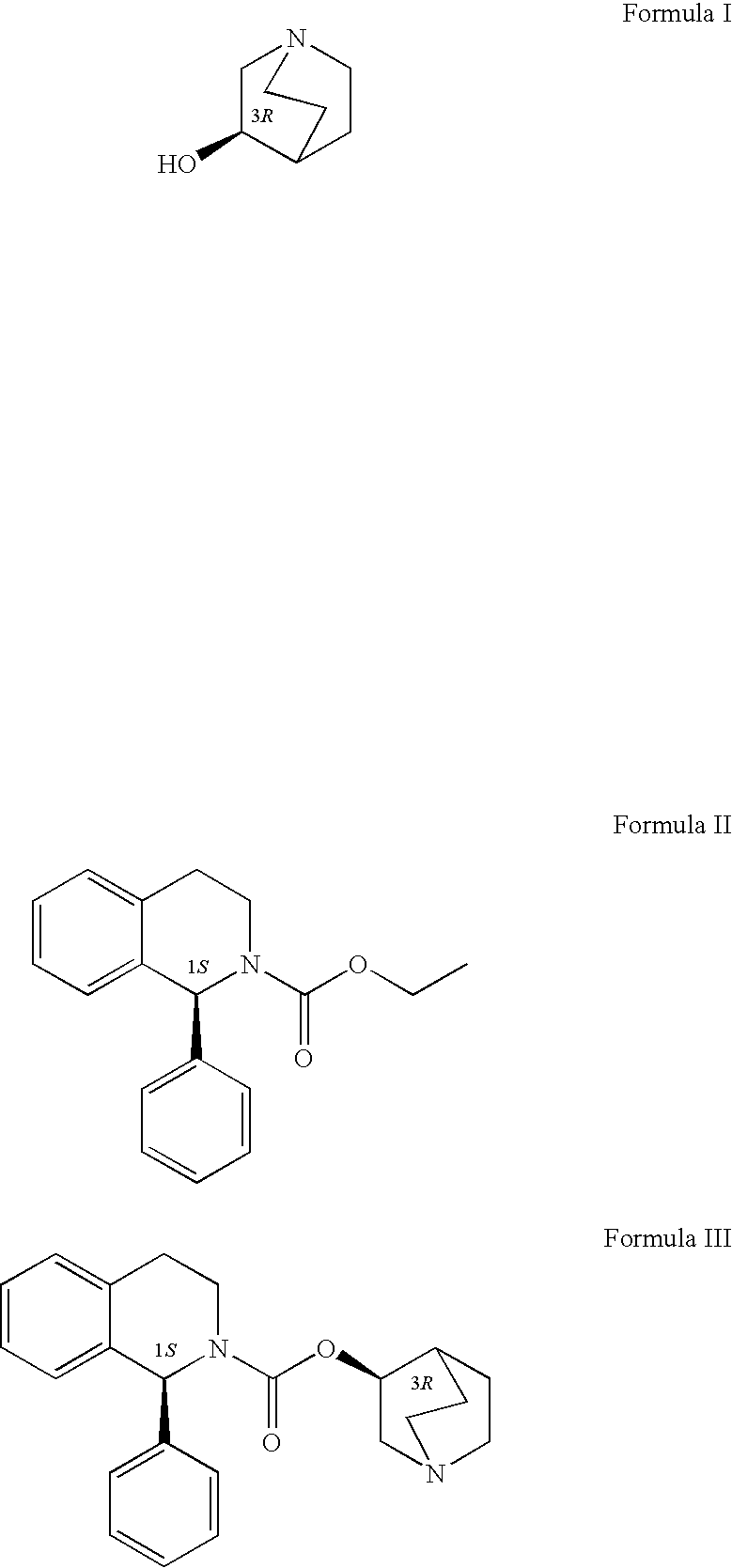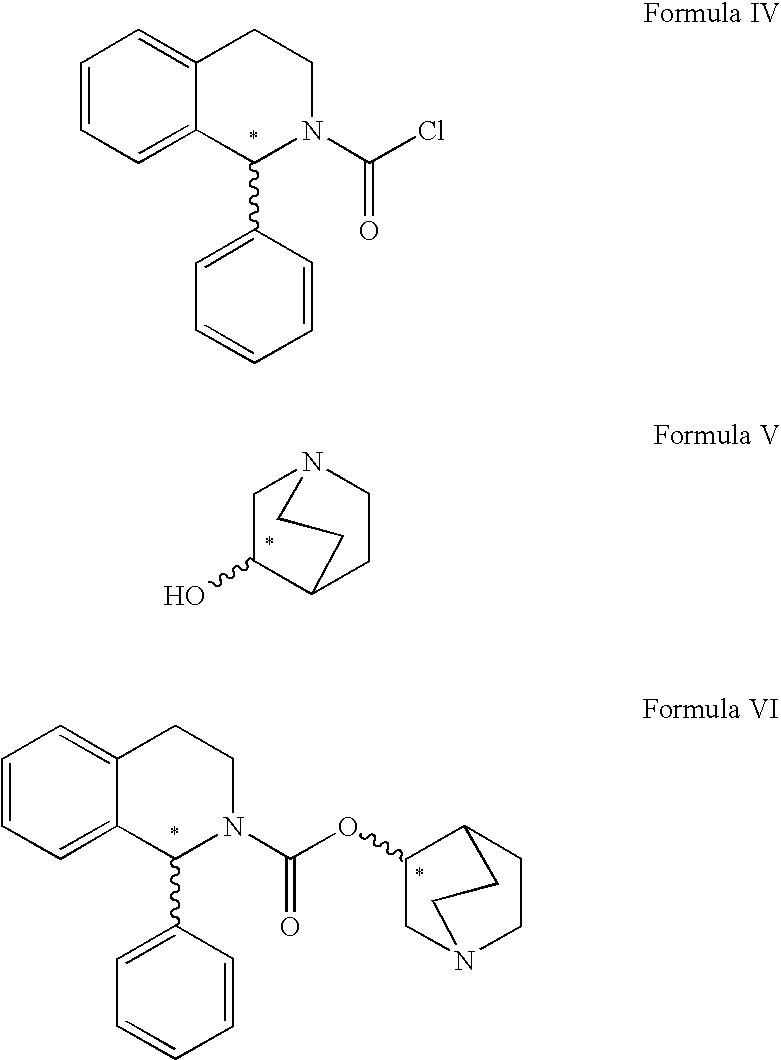Process for the preparation of solifenacin
a technology of solifenacin and process, applied in the field of process for the preparation of solifenacin, can solve the problems of significant limitation of the nucleophilic substitution ability of bases, and achieve the effect of high conversion and very low degree of racemization of both the starting substances and the produ
- Summary
- Abstract
- Description
- Claims
- Application Information
AI Technical Summary
Benefits of technology
Problems solved by technology
Method used
Image
Examples
example 7
[0019]To a solution of 1(S)-ethyl 1-phenyl-1,2,3,4-tetrahydro-2-isoquinoline carboxylate (19.2 mol) in toluene (140 ml) was added 3(R)-quinuclidol (23.04 mmol). The system was heated at 90° C., and after the two starting substances had dissolved completely, potassium tert-butanolate (3.84 mmol) was added to the constantly stirred mixture and the fine suspension formed was heated to boil. While the reaction proceeded, the azeotropic toluene-ethanol mixture was distilled off from the mixture. The reaction was terminated after 3 hours of boil, when GC indicated that a 97% degree of conversion had been reached. A volume of 50 ml of water was added and the mixture was stirred at room temperature for 20 minutes. The toluene layer was allowed to separate in a separating funnel and the aqueous layer was washed with toluene (2×50 ml). The combined organic extracts were washed with 50 ml of water, 25 ml of brine, and 25 ml of water, and evaporated to dryness on a rotary vacuum evaporator. The...
example 8
[0020]To a solution of 1(S)-ethyl 1-phenyl-1,2,3,4-tetrahydro-2-isoquinoline carboxylate (3.6 mol) in toluene (30 ml) was added 3(R)-quinuclidol (4.3.mmol). The system was heated at 90° C., and after the two starting substances had dissolved completely, a 1.8 M solution of lithium diisopropylamide in a THF-heptane-EtOH mixture (0.7 mmol) was added to the constantly stirred mixture, and the whole was heated to boil. While the reaction proceeded, the azeotropic toluene-ethanol mixture was distilled off from the mixture. The reaction was terminated after 6 hours of boil. The mixture was processed conventionally to obtain the product as the HCL salt. Yield of the white crystalline substance: 420 mg (29.2% theory).
example 9
[0021]To a solution of 1(S)-ethyl 1-phenyl-1,2,3,4-tetrahydro-2-isoquinoline carboxylate (3.6 mol) in toluene (30 ml) was added 3(R)-quinuclidol (4.3.mmol). The system was heated at 90° C., and after the two starting substances had dissolved completely, 1,8-diazabicyclo[5.4.0]undec-7-ene (DBU) (0.7 mmol) was added to the constantly stirred mixture, and the whole was heated to boil. While the reaction proceeded, the azeotropic toluene-ethanol mixture was distilled off from the mixture. The reaction was terminated after 6 hours of boil. The mixture was processed conventionally to obtain the product as the HCL salt. The yield of the white crystalline substance obtained was 400 mg (27.8% theory).
PUM
| Property | Measurement | Unit |
|---|---|---|
| temperature | aaaaa | aaaaa |
| volume | aaaaa | aaaaa |
| length | aaaaa | aaaaa |
Abstract
Description
Claims
Application Information
 Login to View More
Login to View More - R&D
- Intellectual Property
- Life Sciences
- Materials
- Tech Scout
- Unparalleled Data Quality
- Higher Quality Content
- 60% Fewer Hallucinations
Browse by: Latest US Patents, China's latest patents, Technical Efficacy Thesaurus, Application Domain, Technology Topic, Popular Technical Reports.
© 2025 PatSnap. All rights reserved.Legal|Privacy policy|Modern Slavery Act Transparency Statement|Sitemap|About US| Contact US: help@patsnap.com



